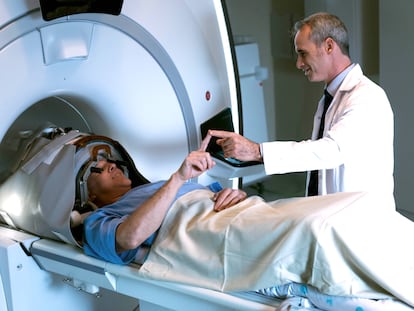Patricia Churchland, the philosopher who looks at neurons
The Canadian neurophilosopher is a pioneer in the study of the relationship between the brain and our ideas

Patricia Churchland, one of the world’s leading experts in neurophilosophy, arrives at our meeting after a busy morning on the phone with other colleagues. Noam Chomsky had published an essay in The New York Times on the weaknesses of ChatGPT, the artificial intelligence tool. Churchland, 79, has her own criticisms. “Its limitations are not the amount of data it can handle. The limitations are about having goals, drives or being worried or wanting to have a nap. For many aspects of moral decision-making and moral learning, you probably need to have what all mammals basically have: the capacity to care for others,” notes the University of California, San Diego professor emeritus.
In her most recent book, Conscience: The Origins of Moral Intuition (2019), Churchland addresses how biological knowledge of the brain explains that we are conscious beings. Humans share the ways in which our nervous systems are wired, but our views of right and wrong may differ beyond our experiences. Years earlier, the scientist had already set the goal of bridging the gap between our minds and our brains. In Braintrust: What Neuroscience Tells Us About Morality, Churchland discusses the importance of oxytocin, a molecule that is crucial for maintaining blood pressure and fluid balance. But it doesn’t just do that: it is also associated with trust, the tolerance of others and can reduce fear.
Born in Oliver, Canada, Churchland grew up on a farm in British Columbia. Her home didn’t have a television. Conversations with her father, a farmer who also edited a small newspaper, and her mother, a devoted nurse, were the main form of entertainment in her small community of less than 4,000 people in western Canada. Neither of her parents had finished high school, but both were curious and asked big questions about the environment, life and religion.
Patricia entered college wanting to be a lawyer, but she soon became interested in philosophy. She thought that, if we want to understand the nature of knowledge and memory, we must understand the brain. She believed that she would find a lot of people in college who cared about that very thing. “Of course, that wasn’t the case,” Churchland laughs. In Pittsburgh, where she did her master’s degree, she met a classmate who had the same curiosity, plus scientific and engineering backgrounds. His name was Paul Churchland; today, he is her husband and a leading figure in the field of neurophilosophy along with Patricia.
At the University of Manitoba, where she started her career as a professor, Patricia Churchland witnessed a scene involving a former dean. The older, very distinguished fellow began to speak for a few minutes, before suddenly, without warning, he began to cry. He cried in the most hideous way. Then he stopped just as suddenly. “The professor said, ‘I’m sorry, I have had a stroke in my brainstem. And suddenly, the circuitry for crying is stimulated. I don’t feel sad when that happens. I look sad. But I feel no sadness at all,’” recalls Churchland, who was struck by how a physical reaction was devoid of feeling.
That was a decisive moment. After that, Churchland began attending the same classes as first-year medical students. She studied anatomy and dissected a human brain to learn about neurons and synapses. The experience helped her write Neurophilosophy, the pioneering book she published in 1986. In it, she broke down the latest scientific developments in brain function; the book has since shaped the field.
In Descartes’ Error: Emotion, Reason, and the Human Brain (1994), renowned neuroscientist Antonio Damasio discusses a common phenomenon among brain-damaged patients. Many of them consider their symptoms to be affectations of their conscious self, but that is not the case. In his work, Damasio cites the Churchlands’ work as evidence.
The revolutions that Churchland foresaw almost 40 years ago are already underway. The first is optogenetics, a process discovered by Karl Deisseroth, a Stanford professor of bioengineering. Optogenetics has made it possible to manipulate the behavior of mice with light stimuli sent to their brains. “It’s meant that we could do something we all knew you really needed to do in neuroscience: find out when a population of cells is doing,” she says. The brain’s magic is not in individual cells, she explains: “An individual cell doesn’t represent the thought that the Earth is spherical, or that it’s raining outside. It requires a population. But without the technique to access populations, it was really hard to know.”
The second area of innovation is neural networks, artificial intelligence composed of algorithms and mathematical formulas that emulate human thinking. Networks have given science more accurate mathematical models to project hundreds of millions of parameters, which are similar to human cells (in ChatGPT’s case, it is billions of parameters). “In a really amazing way, neuroscience and neural network research are kind of holding hands, and what exactly will come up that is not yet clear. But it’s very different from what we as neuroscientists were doing 20 years ago.”
Sign up for our weekly newsletter to get more English-language news coverage from EL PAÍS USA Edition
Tu suscripción se está usando en otro dispositivo
¿Quieres añadir otro usuario a tu suscripción?
Si continúas leyendo en este dispositivo, no se podrá leer en el otro.
FlechaTu suscripción se está usando en otro dispositivo y solo puedes acceder a EL PAÍS desde un dispositivo a la vez.
Si quieres compartir tu cuenta, cambia tu suscripción a la modalidad Premium, así podrás añadir otro usuario. Cada uno accederá con su propia cuenta de email, lo que os permitirá personalizar vuestra experiencia en EL PAÍS.
¿Tienes una suscripción de empresa? Accede aquí para contratar más cuentas.
En el caso de no saber quién está usando tu cuenta, te recomendamos cambiar tu contraseña aquí.
Si decides continuar compartiendo tu cuenta, este mensaje se mostrará en tu dispositivo y en el de la otra persona que está usando tu cuenta de forma indefinida, afectando a tu experiencia de lectura. Puedes consultar aquí los términos y condiciones de la suscripción digital.
More information
Últimas noticias
Most viewed
- Reinhard Genzel, Nobel laureate in physics: ‘One-minute videos will never give you the truth’
- Oona Chaplin: ‘I told James Cameron that I was living in a treehouse and starting a permaculture project with a friend’
- Pablo Escobar’s hippos: A serious environmental problem, 40 years on
- Why we lost the habit of sleeping in two segments and how that changed our sense of time
- Chevy Chase, the beloved comedian who was a monster off camera: ‘Not everyone hated him, just the people who’ve worked with him’











































